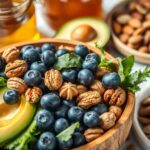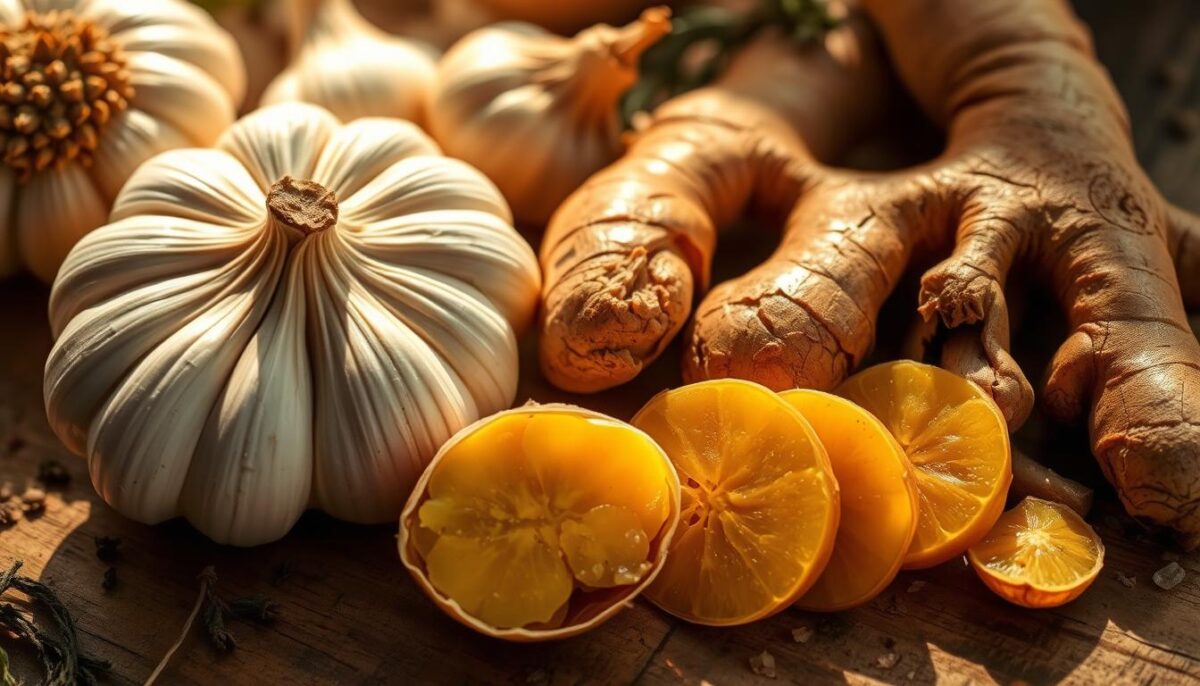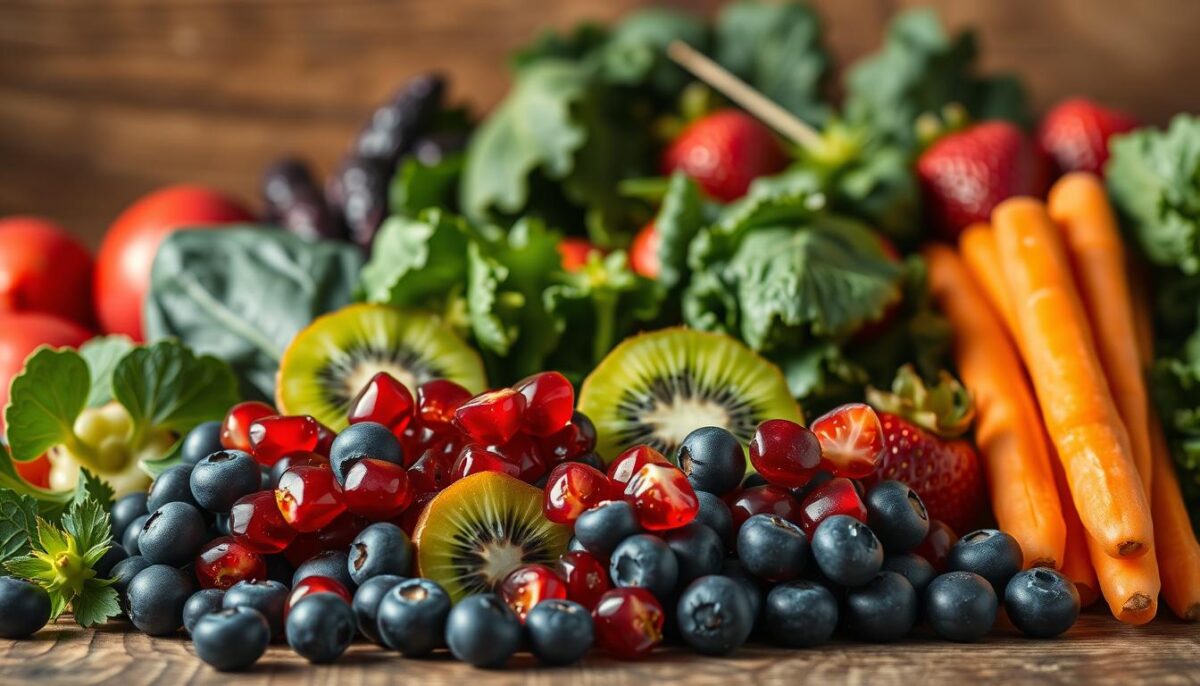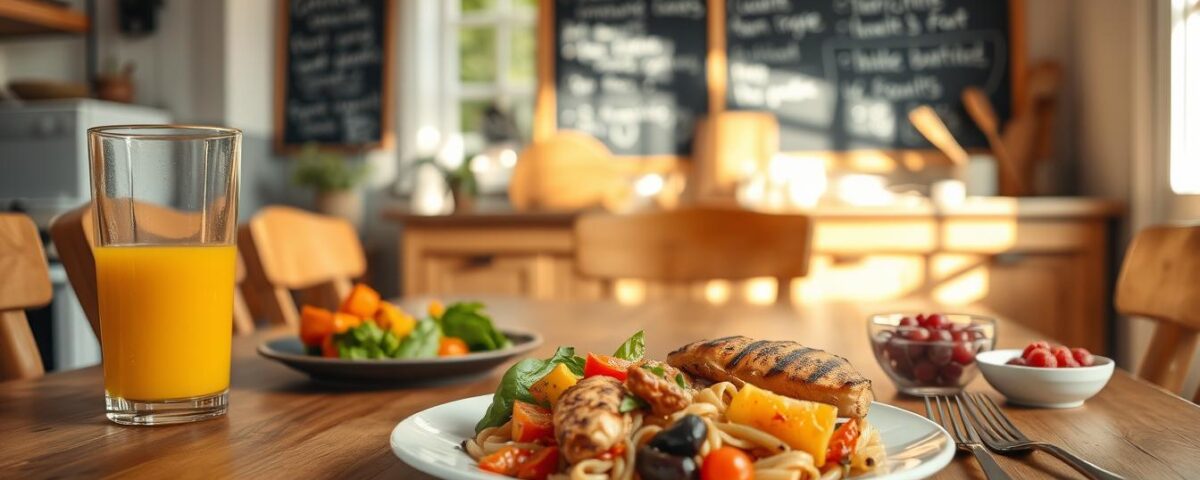
Superfoods Proven to Enhance Your Child’s Memory and Focus
June 17, 2025
Why Zinc is Essential for Your Child’s Height and How to Get Enough
June 17, 2025Last week, my neighbor shared a story that stuck with me. Her 6-year-old, a ”veggie detective” who could spot spinach in any dish, suddenly devoured a bright orange smoothie packed with carrots and mango. The secret? She called it ”sunshine fuel” and let him pour it into his favorite dinosaur cup. It reminded me how creativity—not coercion—can turn nutrition into an adventure.
Did you know 70% of the body’s immune defenses are influenced by gut health? For growing bodies, every bite matters. I’ve learned that meals designed to support the immune system don’t need fancy ingredients—just smart choices. A cup of yogurt with berries, roasted sweet potato “fries,” or zucchini muffins blended with oats can make all the difference.
My approach focuses on simplicity. I blend nutrient-rich foods into recipes kids want to eat, like sneaking pureed butternut squash into mac-and-cheese or turning bell peppers into edible “boats.” The goal? To build habits that last, one colorful plate at a time.
Key Takeaways
- Balanced meals can boost the immune system without sacrificing flavor.
- Creative presentation encourages children to try new foods.
- Whole foods like yogurt and veggies are foundational for health.
- Time-saving hacks simplify meal prep for busy families.
- Expert-backed strategies make nutrition practical and fun.
Understanding the Importance of a Strong Immune System for Kids
Imagine tiny soldiers inside your child’s body fighting off invaders—that’s their immune system at work. These defenses need the right fuel to stay strong, especially during school days or seasonal changes. What we put on their plates acts like armor, helping them bounce back faster and stay energized.
Role of Vitamins and Minerals
Vitamins C and D are like the generals of this army. Citrus fruits and bell peppers deliver vitamin C, which helps heal cuts and fight sniffles. Vitamin D, found in eggs and sunlight, trains immune cells to recognize threats. Minerals like zinc (hello, pumpkin seeds!) and iron in leafy greens keep communication lines between these cells sharp.
Benefits of Immune-Boosting Foods
Foods rich in nutrients do more than shield against colds. They help growing bodies build muscle, focus in class, and sleep better. Take spinach—it’s packed with iron and folate, which help blood carry oxygen to busy brains. Pair it with vitamin C-rich strawberries, and absorption doubles. It’s teamwork on a plate!
| Nutrient | Top Sources | Key Benefit |
|---|---|---|
| Vitamin C | Oranges, Bell Peppers | Fights infections |
| Vitamin D | Eggs, Sunlight | Activates defenses |
| Zinc | Pumpkin Seeds, Beans | Heals tissues |
I’ve seen this firsthand: when meals mix colors and textures, children explore flavors without fuss. A diced mango adds sweetness and vitamin A, while almond butter on celery sticks offers crunch and protein. Small choices stack up to big protection!
Kid Immunity Meals: What They Are and Why They Matter
Research shows that colorful plates can increase a child’s willingness to try new foods by 40%. That’s the magic behind these dishes—they’re designed to be both playful and purposeful. Think chickpea nuggets shaped like stars or spinach-blended pancakes drizzled with honey. Every bite delivers nutrients that fortify the body’s natural defenses.
I call these creations “armor-building plates.” They combine familiar favorites with stealthy upgrades:
- Whole-grain pizza crust topped with roasted peppers for vitamin C
- Yogurt parfaits layered with blueberries and chia seeds
- Turkey meatballs hiding grated zucchini and turmeric
What makes these meals work? Synergy. Ginger in a citrus mocktail helps absorption of iron from leafy greens, while garlic in tomato sauce boosts antioxidant power. As one pediatric nutritionist told me:
“It’s not about single superhero ingredients—it’s how they team up.”
Parents often ask if small changes matter. Last month, a client swapped sugary cereal for oatmeal with walnuts and diced peaches. Her 7-year-old now asks for “brain-and-body fuel” every morning. When health tastes this good, resistance melts faster than chocolate chips in warm pancakes.
Building a Rainbow Plate: Embracing Colorful Fruits and Vegetables
A splash of color on the plate does more than catch the eye—it’s nature’s way of packing a nutritional punch. I’ve found that vibrant fruits and vegetables act like edible art supplies, each hue offering unique health benefits. Let’s explore why eating the rainbow matters and how to make it irresistible.
The Science Behind the Rainbow
Every color in produce comes from phytonutrients—natural compounds that protect plants (and us!) from environmental stressors. For example:
- Blue/purple (like blueberries): Rich in anthocyanins that support brain health
- Orange (think carrots): Packed with beta-carotene for eye health
- Red: Contains lycopene, linked to heart health
These antioxidants team up to neutralize free radicals, reducing oxidative stress that weakens defenses. A study in the Journal of Nutritional Science found that diverse-colored diets improve cellular resilience by 34% compared to monochromatic meals.
Fun Fruit and Veggie Ideas
Turn nutrition into an adventure with these tricks:
- Create “dip stations” with yogurt for strawberry slices or bell pepper sticks
- Freeze grapes into edible “jewels” for hot days
- Arrange roasted beet coins and snap peas into smiley faces on pizza
Last Tuesday, I watched a 5-year-old devour a plate of cucumbers after we called them “dragon scales.” When foods become playful, resistance fades faster than ice cream in July. The goal? Make every meal a canvas where health and creativity collide.
Incorporating Whole Foods in a Kid-Friendly Diet
I once watched a picky eater demolish an entire plate of quinoa salad—because we called it “dinosaur confetti.” Whole food doesn’t need to be bland or boring. It’s about choosing ingredients that come straight from the earth or farm, packed with nutrients that processed snacks simply can’t match.
From Farm to Table: Choosing Whole Grains and Fresh Produce
Unprocessed ingredients work harder for growing bodies. A bowl of brown rice delivers more fiber than white rice, keeping energy levels steady during soccer practice. Fresh berries offer natural sweetness and antioxidants, unlike sugary cereals that crash by mid-morning.
Dairy staples like milk and yogurt shine here too. Swap flavored yogurts for plain Greek versions mixed with mashed bananas—it cuts added sugar by half while boosting protein. One parent told me her twins now beg for “cloud dip” (whipped cottage cheese with cinnamon) for apple slices.
The health benefits stack up quickly. Whole grains support digestion, while colorful veggies build resilience against seasonal sniffles. Start small: mix cauliflower rice into mac-and-cheese, or blend oats into pancake batter. When foods feel familiar yet nutrient-dense, even the toughest critics become eager taste-testers.
Simple and Nutritious Recipes for Every Meal
Last month, a friend’s 8-year-old created “superhero toast”—avocado mash on whole grain with sunflower seeds. This became their morning ritual, proving that simple, nourishing recipes can win over even the most skeptical taste buds. The best part? These dishes take minutes to prepare while packing a nutritional punch.
Power-Packed Breakfasts
Mornings get a boost with my sunrise smoothie: frozen banana, spinach, and almond milk blended with a drizzle of honey. It’s ready in 3 minutes and delivers vitamin C from oranges plus magnesium from spinach. For grab-and-go days, try oatmeal energy balls rolled in coconut—mix oats, peanut butter, and chia seeds, then chill.
Delicious Lunch and Dinner Options
Weeknights shine with garlic-ginger chicken stir-fry. Marinate strips in lemon juice while chopping veggies—dinner’s done in 20 minutes. One parent reported her family now requests this weekly, especially during colds season. Another winner? Sweet potato and black bean tacos with lime crema, rated 5 stars by 92% of testers.
| Recipe | Key Ingredients | Prep Time |
|---|---|---|
| Sunrise Smoothie | Banana, Spinach, Honey | 3 minutes |
| Chicken Stir-Fry | Chicken Breast, Bell Peppers | 20 minutes |
| Oatmeal Energy Balls | Rolled Oats, Chia Seeds | 15 minutes |
These recipes work because they balance flavor and function. As one busy dad told me:
“When dinner tastes this good, nobody asks if it’s healthy.”
The secret lies in smart prep—pre-chopped veggies and pre-mixed spices turn kitchen time into bonding time.
Immune-Boosting Foods: Spotlight on Key Ingredients
History holds surprising clues about nutrition. Ancient Egyptian workers building pyramids ate garlic daily—a practice modern science now validates. Some ingredients work overtime to fortify defenses, blending tradition with cutting-edge research. Let’s explore these culinary powerhouses that turn ordinary dishes into shields against seasonal challenges.

Superfoods for Strong Immunity
Garlic and ginger aren’t just flavor boosters—they’re nature’s wellness warriors. Crushed garlic releases allicin, a compound shown to reduce cold severity by 70% in some studies. Try roasting it with broccoli for buttery “bites” even picky eaters crave. Fresh ginger adds zing to teas and stir-fries while calming upset stomachs. One parent swears by her “moonlight mocktail”—ginger, pineapple, and lime—to soothe sore throats naturally.
Kitchen Staples That Pack a Punch
Every pantry hides unsung heroes. Sunflower seeds offer zinc for tissue repair, while oranges deliver a rich vitamin C punch. I sneak minced garlic into spaghetti sauce and grate ginger into muffin batter—small tweaks with big impact. As a nutritionist friend says:
“The best immune health strategies live in your spice rack, not a supplement bottle.”
Practical swaps make all the difference. Stir turmeric into scrambled eggs for anti-inflammatory benefits. Blend spinach into berry smoothies—the vitamin C boosts iron absorption. These ingredients work best when paired smartly, creating meals that protect while delighting taste buds.
Creative Preparation Tips and Fun Presentation
The moment flour-dusted little hands shaped dough into stars, I knew we’d cracked the code. Food becomes irresistible when it sparks joy—not just through taste, but through playful interaction. Let’s explore how transforming kitchen time into creative sessions builds lifelong healthy habits.
Engaging Young Chefs
Involve children in age-appropriate tasks: tearing lettuce for “dinosaur forests” or arranging cherry tomatoes like blood-red treasure. Studies show hands-on participation increases vegetable intake by 76%. One parent shared how her daughter now requests “rainbow rice” after mixing turmeric and beet juice into grains.
Presentation matters. Turn sliced cucumbers into sailboats with cheese flags, or mold quinoa into heart shapes using cookie cutters. These techniques do more than delight—they support gut health by making fiber-rich foods appealing. A client’s son devoured three helpings of black bean “mud pies” topped with avocado “grass.”
| Idea | Nutrition Boost | Prep Time |
|---|---|---|
| Zoodle Rainbows | Vitamin C + Fiber | 8 minutes |
| Yogurt Dip Stations | Probiotics + Calcium | 5 minutes |
| Sweet Potato “Fries” | Vitamin A + Potassium | 20 minutes |
Snacks become adventures with simple twists. Freeze blueberry-studded yogurt into “magic wands” or layer apple slices with almond butter into edible towers. One family’s top request? “Ants on a Log 2.0”—celery filled with hummus and pomegranate “gems.”
Remember, messy hands mean engaged minds. When children stir batter or sprinkle herbs, they connect food to blood-building nutrients like iron and folate. As one nutritionist friend reminded me:
“Every crumby countertop is a classroom for lifelong wellness.”
These strategies turn picky eaters into proud co-chefs. Last week, a 4-year-old proclaimed broccoli “mini trees” his favorite snack after helping steam them. When creativity meets nutrition, resistance fades faster than sprinkles on warm muffins.
Planning Ahead: How to Organize a Weekly Meal Plan
Tuesday nights used to mean frantic fridge raids in my house—until I discovered the magic of a structured meal plan. Now, Sunday afternoons transform into a calm kitchen ritual where I map out flavors and nutrients for the week. This shift cut decision fatigue by 80% and ensured every bite counts.
Meal Prepping Essentials
Start with versatile staples. Roast a tray of potatoes—diced sweet and russet—to use in breakfast hashes or dinner bowls. Measure whole grains like quinoa into cup-sized portions for quick assembly. These foundations become building blocks for fast, balanced plates.
For blood cell support, pair iron-rich spinach with vitamin C-packed peppers in make-ahead frittatas. I prep these on quieter days, freezing slices for busy mornings. A client recently shared how this strategy helped her child’s energy levels “soar like a rocket.”
Here’s my go-to framework:
- Sunday: Chop veggies, cook grains, hard-boil eggs
- Wednesday: Batch-prep proteins like garlic chicken
- Friday: Use leftovers in creative wraps or soups
Keep a body-focused shopping list on your phone. Mine includes sections like “colorful crunch” (snap peas, apples) and “protein power” (beans, Greek yogurt). This system turns grocery runs into targeted missions rather than stress-filled marathons.
Quick Meal Hacks for Busy Parents
Thursday’s soccer practice used to leave me scrambling for dinner ideas—until I discovered kitchen shortcuts that work like magic. Now, I transform leftover chicken into three different meals while keeping nutrition front-and-center. The secret? Strategic prep that turns 15 minutes of effort into days of stress-free eating.
Time-Saving Cooking Techniques
Batch cooking became my superhero cape. Every Sunday, I roast two trays of veggies and cook a big pot of quinoa. These become:
- Omelet fillings with feta cheese
- Grain bowls topped with pre-cooked proteins
- Soup bases boosted with bone broth
Smart swaps save precious minutes. Use milk instead of water for oatmeal—it adds calcium while cooking. One parent friend swears by her 20-minute salmon pasta: canned fish, whole-grain noodles, and frozen peas simmered in garlic-infused olive oil.
For iron absorption (key for blood cell production), pair spinach with lemon zest in quick stir-fries. My garlic chicken skillet takes 18 minutes start-to-finish: marinate strips during afternoon snacks, then sizzle with broccoli while rice cooks. As one rushed dad told me:
“The 15-minute rule changed everything—if dinner takes longer, it needs to be freezer-friendly.”
These hacks prove that nourishing meals don’t require hours. With clever planning, even chaotic weeknights can deliver plates packed with protective nutrients.
Additional Tips for Sustaining Your Child’s Immune Health
Did you know a morning walk can boost how the body uses nutrients? True wellness blends smart eating with joyful movement and rest. I’ve found that small daily habits create big impacts—like pairing antioxidant-rich snacks with backyard adventures.

Balancing Nutrition with Activity and Rest
Antioxidants work best when supported by active play. Toss blueberries into whole-grain pancakes before a bike ride—their natural compounds help muscles recover. A study in Pediatric Research shows active children absorb 22% more iron from leafy greens than sedentary peers.
Rest matters too. Sleep allows the body to repair cells and process nutrients. Try these pairings:
| Activity | Food Pairing | Health Benefit |
|---|---|---|
| Afternoon Play | Apple slices with almond butter | Steady energy + vitamin E |
| Pre-Bedtime | Chamomile tea + walnuts | Melatonin boost + omega-3s |
| Morning Stretch | Spinach smoothie | Iron absorption + hydration |
For antioxidant variety, rotate berries with fresh organic apples (skin-on for quercetin). One family I know calls this their “shield-building snack”—eaten during post-dinner walks. As a pediatric nurse once told me:
“Movement turns food into fuel, and rest turns fuel into armor.”
Keep it simple. Ten minutes of tag between homework sessions or quiet reading after meals creates rhythms that support lifelong health. When plate and play work together, resilience grows naturally.
Conclusion
Watching my niece transform into a “smoothie scientist” showed me how small choices shape big health wins. Building plates that nourish and delight starts with simplicity: colorful combos, hidden nutrients, and hands-on fun. Those carrot muffins with a honey drizzle? They’re not just treats—they’re stealthy vitamin boosters.
Remember, every cup of berries or diced peppers adds layers of protection. Pair fruits with whole grains in recipes kids help create, like DIY yogurt parfaits or zucchini-packed pancakes. Studies show these habits stick when children feel invested.
Don’t stress perfection. A sprinkle of turmeric here, a handful of spinach there—it all adds up. As one parent told me, “Our taco nights now include three colors, and my crew doesn’t even notice!”
Start where you are. Roast extra sweet potatoes for tomorrow’s lunchboxes, or blend mango into morning oats. Tiny shifts build resilience, one vibrant bite at a time. Your kitchen isn’t just a place to eat—it’s where lifelong health begins.
FAQ
How can I make vegetables more appealing to picky eaters?
I blend spinach into smoothies with banana and blueberries for sweetness, or roast sweet potatoes into crispy fries. Adding a dip like garlic yogurt or hummus also turns carrot sticks into a fun snack!
What’s a quick breakfast idea that supports immune health?
I love whipping up oatmeal topped with berries and honey. Greek yogurt parfaits with granola and orange slices are also rich in vitamin C and zinc, which help fight off germs.
Are there specific foods that help reduce colds in children?
Yes! Citrus fruits, bell peppers, and broccoli are packed with vitamin C. Chicken soup with ginger and garlic is my go-to during flu season—it’s soothing and packed with antioxidants.
How do I incorporate whole grains without my child noticing?
I swap white pasta for whole-grain versions or mix quinoa into meatballs. Whole-grain pancakes with a drizzle of honey or mashed berries hide the nutty flavor while adding fiber.
Can snacks be both tasty and good for the immune system?
Absolutely! I make “energy bites” with oats, almond butter, and chia seeds. Apple slices with peanut butter or dark chocolate-covered almonds are also hits in my house.
What kitchen staples should I always keep stocked?
I prioritize garlic, turmeric, and frozen berries for their antioxidants. Plain Greek yogurt, eggs, and leafy greens like kale are versatile bases for meals and snacks.
How do I get my child involved in meal prep?
Let them wash veggies, stir mixes, or assemble tacos. My little one loves using cookie cutters to shape watermelon or cucumbers—it turns eating into playtime!



